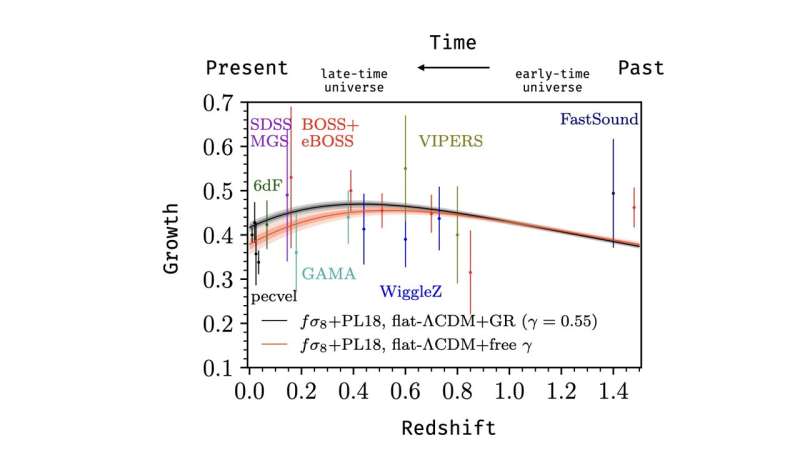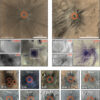The large-scale structure of the universe—the gigantic, hierarchical cosmic web of structures bound by gravity—is mostly made up of dark matter. The growth of the large-scale structure, from individual galaxies to galaxy clusters, cosmic voids and filaments (Fig. 1), revolves around a competition: Gravity pulls matter together while dark energy pushes space apart. The distribution and evolution history of matter and large-scale structure therefore provide an avenue to study the properties and nature of dark matter, gravity and dark energy.
In fact, current cosmological observations do not agree on the distribution of matter in the present-day universe. The disagreement is quantified using a measure called S8 that characterizes matter’s “clumpiness” on a characteristic scale of roughly 8 Megaparsecs (about 26 million light years).
Cosmic microwave background experiments, which collect photons from the early universe and hence are more sensitive to early-time physics, report a higher S8 value than galaxy weak gravitational lensing surveys, which measure galaxy shapes and positions in an older universe and thus are more sensitive to late-time physics. This discrepancy—known as the S8 tension—is part of the broader cosmological crisis, including the H0 tension, where parameters in the standard cosmological model like S8 and H0 do not align between early and late universe observations.
What happens to the late universe?
If of physical origin, what are the implications of the S8 tension to the growth of large-scale structure? A good way to seek a clear answer to this question is to cleanly separate the growth history of cosmic structures, i.e., the clumpy universe, from the expansion history of cosmic background, i.e., the smooth universe.
Within the standard model, almost 70% of the universe is filled with a constant dark energy and this component drives the expansion of the cosmic background. Dark energy and the cosmic background expansion, acting like molasses, naturally suppress cosmic structure growth. That is, they act like a friction against the attraction and clustering of matter. This fact is already accounted for in all cosmological analyses. So the S8 tension indicates a further suppression, beyond the standard model’s expectation.
Evidence for growth suppression beyond the standard model and implications for S8 tension
In an analysis recently published in Physical Review Letters as an Editor’s Suggestion, adopting the growth-expansion separation strategy, we analyzed multiple cosmological data sets characterizing the growth of cosmic structures at multiple cosmic epochs. Specifically, we explored the question, whether, when and by how much the growth history of large-scale structure deviates from the standard model’s picture.

Figure 2. © Nhat-Minh Nguyen
Fig. 2 shows our constraints on large-scale structure growth, from the same data, in two scenarios: the standard model (black) and an extended model (orange) where structure growth is allowed to decouple from the background expansion. Data from both early- and late-time universe collectively prefer a growth suppression beyond that predicted by the standard model. The evidence comes in at 4.2-sigma level of statistical significance, providing substantial evidence against the standard model.
Interestingly, the growth suppression with respect to the standard model’s scenario becomes prominent at relatively late time. In particular, the deviation only becomes statistically significant after the onset of dark energy. That is, cosmic structures grow even slower than expected in a universe filled with and dominated by constant dark energy. This, for example, could imply a new property of dark energy in particular, or modified theory of gravity in general.
All data sets, and combinations thereof, that we consider support the scenario of a late-time suppressed growth—more than expected in the standard model—and this will affect the late-time extrapolation more. Such a scenario naturally alleviates the S8 tension, as illustrated in the left panel of Fig. 3 where early-time (pink) and late-time (blue) measurements now agree perfectly, while leaving the H0 tension unaffected (right panel of Fig. 3).

Figure 3. © Nhat-Minh Nguyen
How so? Recall that the S8 tension is the discrepancy between measurements of matter’s clumpiness in early- and late-time universes, both extrapolated to the present day assuming the standard model. If growth of large-scale structure has only recently been suppressed—more than expected by the standard model—that would affect the measurements and extrapolations precisely in the way that reduces the S8 value from the early-time probes while increasing its value from the late-time ones.
Going beyond the standard model
It is still early to conclude whether cosmologists, including us, are discovering chinks in the standard model’s armor or unaccounted for systematic errors in the aforementioned analyses.
On one hand, invoking new, late-time physics that suppresses growth of structure—e.g., novel gravity and dark energy properties or new dark matter interactions—to resolve the S8 tension is definitely an option. On the other hand, it is still possible that individual cosmological probes that we and others examined are plagued by unknown unknowns from complicated astrophysical processes that affect the measurements and/or analyses in certain ways that ultimately result in a tension.
The study of cosmic large-scale structure therefore opens an exciting window to look for physics beyond our standard picture of the universe, be it new theories of gravity, dark matter and dark energy or new models of galaxy formation and evolution. The cosmological crisis is actually fascinating for both cosmologists and astrophysicists, especially as more data at high precisions keep coming in.
In our case, we shall look into both data from new, independent experiments but similar to those we analyzed, and data from new surveys that probe the universe at new times (and scales).
This story is part of Science X Dialog, where researchers can report findings from their published research articles. Visit this page for information about ScienceX Dialog and how to participate.
More information:
Nhat-Minh Nguyen et al, Evidence for Suppression of Structure Growth in the Concordance Cosmological Model, Physical Review Letters (2023). DOI: 10.1103/PhysRevLett.131.111001. On arXiv: DOI: 10.48550/arxiv.2302.01331
Nhat-Minh Nguyen, also Minh Nguyen, is currently a Leinweber Postdoctoral Research Fellow at the Leinweber Center for Theoretical Physics, University of Michigan. His current research focuses on understanding and modeling the growth of cosmic structures throughout the entire history of the universe, in order to shed light on cosmological models and gravity theories.
Citation:
Growing in molasses: Cosmic large-scale structure caught growing slower than expected (2023, October 2)



